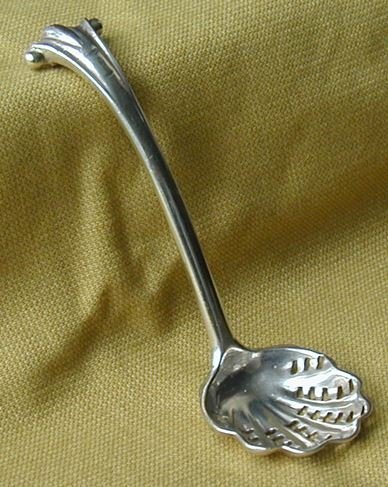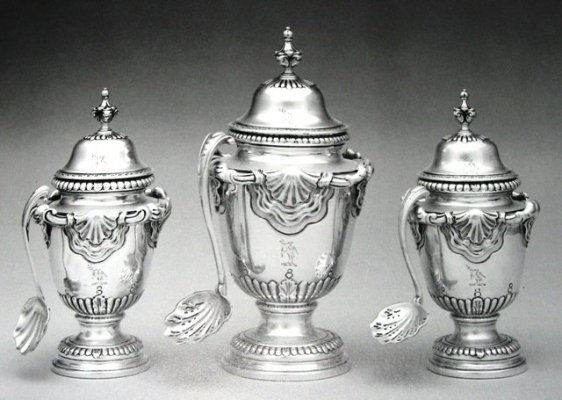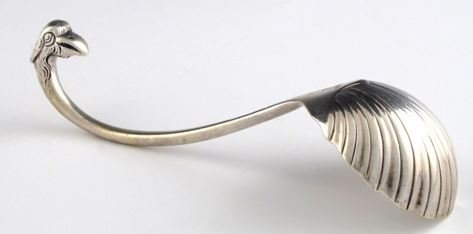|
|
In this Forum we discuss the silver of the United Kingdom, as well as British Colonial silver and Old Sheffield Plate. Past British - Irish Sterling topics/threads worth a look. |
|
|
| How to Post Photos | Want to be a Moderator? |
|
|
In this Forum we discuss the silver of the United Kingdom, as well as British Colonial silver and Old Sheffield Plate. Past British - Irish Sterling topics/threads worth a look. |
|
|
| How to Post Photos | Want to be a Moderator? |

|
 SMP Silver Salon Forums SMP Silver Salon Forums
  British / Irish Sterling British / Irish Sterling
  Onslow pattern Onslow pattern
|
| next newest topic | next oldest topic |
| Author | Topic: Onslow pattern |
|
mdhavey unregistered |
 
Here's a fascinating stuffing spoon--was picked up at a local New England country auction for small money. Didn't have much time to examine it, but thought it was the real mcoy. IS IT?? I think the date mark is London 1762 - 3, but what happened to the silver around the date I can't tell. Also can't tell the maker. Anybody?  IP: Logged |
|
swarter Moderator Posts: 2920 |
  
This date letter, whichever it is, is from the 1756-1765 date cycle. The date therefore is right for the style, which appeared in this form around 1760. The maker, whose script mark is shown inverted in the photo, may be Thomas Powell, whose marks were registered in 1756 and 1758. The irregularities below and to the side of the date mark appear to be caused by a repair, which has obscured part of the letter; also the punch may have been a bit too wide to fit within the confines of the narrow stem and overlapped the sides and the mark is thus incomplete. The Onslow terminal was cast, while the rest of the spoon was forged, so the terminal has to be attached by a solder joint. Onslow terminals have been added to spoons of other styles by cutting off the original ends and soldering on the Onslow terminals. Onslow examples are desireable and are not common, which has led to fakery. To ensure yours is genuine (which should be done when there are casting flaws as there seem to be on yours, in form of pits from trapped air bubbles) the solder joint should be examined - original terminals were usually attached via a slanted scarf joint, wheras most fakes are attached by a square-cut butt joint. That joint should be near the terminal, so the solder near the marks, which should be near the bowl, is probably an honest repair, but if you cannot find another solder joint further up the stem, then the terminal may be suspect (but the rest of the spoon would be genuine, anyway). Try breathing on the stem, as you would to clean a pair of glasses, and the joint should be revealed as the film of moisture evaporates. If genuine, you have made a nice find! IP: Logged |
|
mdhavey Posts: 167 |
  
What a great reply. Indeed, there is a scarf joint. An upper joint on one side and a lower on the other. Do you know how long this pattern (Onslow) was made in England? I know there is a version made in the US, early 20 th century by Tuttle. IP: Logged |
|
Melissa unregistered |
 
Hello, according to Pickford's book on flatware, Onslow was 'first produced in its recognised form about 1760' and continues through today, although deLamerie and others made a similar pattern as early as the 1730's. Some called the pattern Scroll. He continues on to say that genuine examples are hard to find and most are serving pieces. There is one complete table service known, dating from the Regency period. Good buy! IP: Logged |
|
swarter Moderator Posts: 2920 |
  
quote: Congratulations and welcome to the forums. IP: Logged |
|
ahwt Posts: 2377 |
  
 Above is a spoon I found at the Nashville Antiques and Garden show. It is a large serving spoon (10 7/8 inches long) with a date mark of 1763 and the city mark for London. The sponsor’s mark is for James Tookey. The spoon has a crest in the form of what may be a bear’s claw and a monogram M. It also has an attractive double drop. Mindful of Swarter’s admonition to check the joint between the cast scroll and the handle of the spoon I breathed on the spoon, but no condensation formed. The cold weather has caused our furnace to run so long that the humidity in our house has dropped to 10%. I had to put the spoon in the freezer for awhile so that when I blew on it moisture would form. This worked and after blowing on the spoon I could see a scarf joint running from the bottom line of the crest to about an inch lower on the top of the spoon. The Lady Carnarvon, the Mistress of Downton Abbey, was the keynote speaker at this antique show. Several antique dealers reported customers using images from the Downton Abbey TV show as a guide for what to buy and they were pleased to help them. I don’t think I have seen any Onslow pattern spoons on this show, but the beautiful sets shown on that show may have been the reason I brought this spoon. The Nashville Antiques and Garden Show dealers are now in the new Music City Center on Demonbreun Street in Downtown Nashville. This show has lost dealers in both the antique section and the garden section in recent years, but still is a very attractive show. IP: Logged |
|
agphile Posts: 798 |
  
That is what I think of as a nice, classic example of the Onslow pattern. I am probably adding information you already know, but in Fairbairn’s Crests the bear’s paw erect is attributed to Alland. This probably means that the crest and the engraved W refer to two separate owners unless, say, an American family with initial W had simply chosen to adopt the crest. Perhaps I might add a bit more about the pattern and some of its variants. I find a straightforward Onslow like yours more pleasing than those which add other decoration such as the example below with feather edging and shoulders at the base of the stem, marked RR (unidentified), London, 1772. And it is not necessarily the case that an Onslow piece must have a scarf joint. The smaller examples in particular, such as teaspoons or condiment ladles, were often made in one piece. The teaspoon below was cast in one piece. It is punched with DS (Dorothy Sarbitt, entered 1753) and a lion passant. Larger pieces too may be genuine but still lack the scarf joint. My spoonmaker friend tells me that an Onslow terminal can be shaped by sawing and filing rather than made as a separate casting. The thing to arouse real suspicion is not the lack of a scarf joint but the presence of a different style of joint (e.g. butt or lap). IP: Logged |
|
ahwt Posts: 2377 |
  
Thanks Agphile for the interesting information and pictures of other Onslow pattern forms. I had been looking for this pattern for some time and was happy to find it in person rather than on the internet. The dealer I bought it from was knowledgeable about the scarf joint and that is something hard to find out about from internet pictures. I suspect the the Bear's claw erect was used by "W" as a decoration for their silver as that crest shows up quite often on English silver. Thanks again for the information. IP: Logged |
|
agphile Posts: 798 |
  
I’m now going to be a bit self-indulgent and post more about the Onslow pattern than most would want to know. Living in England and collecting silver for several decades now, I’ve picked up quite a few examples that illustrate small variations of interest to me at least. I’m afraid my self-indulgence has extended to not taking new photos but extracting pictures of variable quality from my records, so apologies for my laziness in this regard.  This small (4 inches) sifter ladle was cast in one piece and is unmarked. I think it is relatively early. Though a bit less ornate it has stylistic similarities to the unmarked ladles associated with a set of Delamerie condiment jars of 1749 in the Gilbert Collection.  Sadly I don’t have a set of condiment jars myself, but I do have a set of ladles that once adorned such jars. The three ladles to the left of the second picture form this set. The first picture gives a different view of one of them, showing the hook by which they were hung. The ladle on the right of the second picture is not part of the set but is by the same maker. Its handle is cast from the same mould as that of the larger ladle in the set and its bowl has the same style of piercing. It was not made to be suspended so no hook on the back and the bowl at more of a right angle to the stem. Note that on this version of Onslow the moulding runs the full length of the stem. I shall pause here, but with the warning that I have a few more Onslow pieces that I am minded to share once I have dug out and uploaded their pictures. IP: Logged |
|
Scott Martin Forum Master Posts: 11573 |
  
Very interesting...looking forward to more. Thanks for sharing this. IP: Logged |
|
agphile Posts: 798 |
  
The Onslow or Scroll design first appeared when Hanoverian, with its up-turned stem end, was the prevailing flatware pattern. I suspect it was first used for ladles before spreading to other serving pieces. It was not the only design that gave ladle handles a simple backwards curve rather than the S shape of a Hanoverian ladle.  This Eagle’s Head sauce ladle is by James Morison, London, 1749: the same year as the Delamerie jars, illustrated in my earlier post, that were accompanied by Onslow style ladles. However, the Onslow scroll was to become the more popular form, perhaps because it lent itself to spoons as well as ladles as well as possibly being a bit simpler to make. Here are a couple of long serving spoons made 10 years later in 1759, the first by Ebenezer Coker and the second by Isaac Callard. Note the variations in the detail of the moulding at the stem end. A more marked variation is found on this 1758 soup ladle by Thomas Heming. The Onslow pattern is generally found on serving pieces of all sizes from salt spoons to soup ladles or “basting” spoons. Basically, the 18th century examples were designed to accompany the salt cellar, sauce boat, tureen or tea service rather than to match a service of knives, forks and spoons. One of the reasons the pattern seems rare is that there will only have been a handful of serving pieces to set against any flatware service – and of course serving pieces were not restricted to the Onslow pattern.Martin (edited 12-08-2016).] IP: Logged |
|
ahwt Posts: 2377 |
  
Agphile, Thanks for the great information and pictures. The variations really are significant and show a fascinating side to the development of the Onslow pattern. Did many of the silversmiths that started with a variation switch over to the more common pattern? I suspect that pure copying may not have been what these early smiths wanted to do. On the other hand they did want to make a living. IP: Logged |
|
agphile Posts: 798 |
  
I haven’t seen, or don’t recall seeing, enough Onslow pieces from any given workshop to risk a judgement as to whether individual makers tended to persist with their own versions of Onslow. The use of variant forms certainly continued. Within the last week or so I saw an Onslow sauce ladle from the 1790s in a local antiques shop. Its terminal was in a similar style to that on the 1759 Ebenezer Coker spoon that I illustrated earlier. However, when I look at my handful of Onslow spoons from the 1770s they all have similar “classic” terminals. The variety lies in whether or not they have shoulders and whether or not they are feather edged. I believe this to be pretty typical of the majority by then but there will always have been exceptions to the rule. I guess that most of the time the majority of spoonmakers were churning out what the customers wanted, or were thought to want, and therefore stuck to the standard pattern. However at the top end of the market and with customers who wanted something a bit different there would have been the opportunity for a bit of variety. IP: Logged |
All times are ET | next newest topic | next oldest topic |
  |
|
Ultimate Bulletin Board 5.46a
|
1. Public Silver Forums (open Free membership) - anyone with a valid e-mail address may register. Once you have received your Silver Salon Forum password, and then if you abide by the Silver Salon Forum Guidelines, you may start a thread or post a reply in the New Members' Forum. New Members who show a continued willingness to participate, to completely read and abide by the Guidelines will be allowed to post to the Member Public Forums. 2. Private Silver Salon Forums (invitational or $ donation membership) - The Private Silver Salon Forums require registration and special authorization to view, search, start a thread or to post a reply. Special authorization can be obtained in one of several ways: by Invitation; Annual $ Donation; or via Special Limited Membership. For more details click here (under development). 3. Administrative/Special Private Forums (special membership required) - These forums are reserved for special subjects or administrative discussion. These forums are not open to the public and require special authorization to view or post. |
|
copyright © 1993 - 2022
SM Publications
All Rights Reserved. Legal & Privacy Notices |